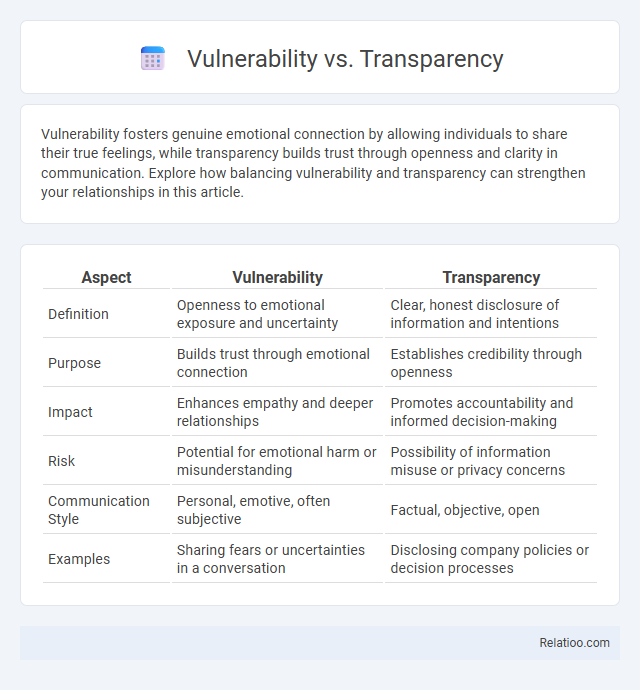Vulnerability fosters genuine emotional connection by allowing individuals to share their true feelings, while transparency builds trust through openness and clarity in communication. Explore how balancing vulnerability and transparency can strengthen your relationships in this article.
Table of Comparison
| Aspect | Vulnerability | Transparency |
|---|---|---|
| Definition | Openness to emotional exposure and uncertainty | Clear, honest disclosure of information and intentions |
| Purpose | Builds trust through emotional connection | Establishes credibility through openness |
| Impact | Enhances empathy and deeper relationships | Promotes accountability and informed decision-making |
| Risk | Potential for emotional harm or misunderstanding | Possibility of information misuse or privacy concerns |
| Communication Style | Personal, emotive, often subjective | Factual, objective, open |
| Examples | Sharing fears or uncertainties in a conversation | Disclosing company policies or decision processes |
Understanding Vulnerability and Transparency
Understanding vulnerability involves recognizing and embracing emotional openness, which fosters genuine connections and personal growth. Transparency promotes trust and accountability by encouraging clear and honest communication within relationships and organizations. Balancing vulnerability and transparency enhances psychological safety, enabling deeper empathy and collaborative problem-solving.
Key Differences Between Vulnerability and Transparency
Vulnerability involves openly sharing personal emotions and struggles, while transparency focuses on honesty and clarity in communication without necessarily exposing emotional depth. Vulnerability often requires a risk of emotional exposure, enhancing trust and connection, whereas transparency is about providing clear, accurate information to foster understanding. Your ability to balance vulnerability and transparency strengthens relationships by combining emotional openness with truthful communication.
The Power of Vulnerability in Communication
The power of vulnerability in communication fosters trust and authentic connections by encouraging openness and emotional honesty. Embracing vulnerability allows individuals to express genuine feelings and thoughts, which enhances empathy and mutual understanding. Transparent communication rooted in vulnerability breaks down barriers, promotes psychological safety, and drives effective collaboration in personal and professional relationships.
Transparency as a Trust-Building Tool
Transparency fosters trust by openly sharing information, demonstrating accountability, and reducing uncertainty in relationships. While vulnerability involves exposing personal weaknesses and can build emotional connection, transparency focuses on clear, honest communication about processes and intentions to create reliability. You can strengthen trust in personal or professional contexts by prioritizing transparency to ensure clarity and mutual understanding.
Emotional Impact: Vulnerability vs Transparency
Vulnerability evokes deep emotional resonance by revealing raw feelings and personal struggles, fostering genuine connection and empathy. Transparency involves openness and honesty about facts or intentions but may lack the emotional depth that vulnerability provides. The emotional impact of vulnerability surpasses transparency by inviting trust through shared human experiences rather than merely presenting clear information.
When Vulnerability Becomes an Asset
When vulnerability becomes an asset, it fosters genuine connections and trust by encouraging open communication and emotional authenticity. Transparency enhances this effect by revealing intentions and building accountability, but vulnerability alone drives deeper engagement through empathy and relatability. Embracing vulnerability strategically transforms perceived weaknesses into strengths that strengthen personal and professional relationships.
Maintaining Boundaries: Balancing Transparency
Maintaining boundaries between vulnerability and transparency requires clear communication to protect personal privacy while fostering trust in relationships. Transparency involves sharing relevant information openly, whereas vulnerability includes expressing deeper emotions that may render one susceptible to judgment or harm. Balancing these elements optimizes connection without compromising emotional safety, ensuring authenticity within appropriate limits.
Real-World Examples: Vulnerability and Transparency in Action
Organizations like Patagonia exemplify the power of combining vulnerability and transparency by openly sharing challenges in their environmental initiatives, fostering consumer trust and loyalty. In the tech industry, companies such as Microsoft publicly disclose software vulnerabilities and their remediation plans, demonstrating accountability and commitment to user security. These real-world examples highlight how embracing both vulnerability and transparency can enhance credibility, drive engagement, and promote ethical business practices.
Navigating Risks: Pitfalls and Best Practices
Navigating risks involves balancing vulnerability, transparency, and accountability to protect your organization from security threats while fostering trust. Excessive vulnerability can expose critical systems to cyberattacks, whereas insufficient transparency undermines stakeholder confidence and regulatory compliance. Implementing best practices such as regular risk assessments, clear communication protocols, and robust cybersecurity measures ensures effective risk management and resilience.
Choosing the Right Approach for Personal and Professional Growth
Choosing the right approach for personal and professional growth involves balancing vulnerability and transparency effectively. Vulnerability allows you to embrace imperfections and foster genuine connections, while transparency builds trust and clarity in communication. By understanding when to be vulnerable and when to maintain transparency, you can create authentic relationships and improve your decision-making process.

Infographic: Vulnerability vs Transparency
 relatioo.com
relatioo.com